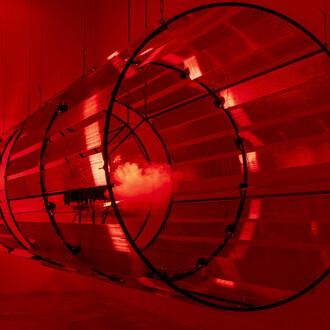On the dark stage
Parrala holds
a dialogue
with death.
Calls her,
she won’t come,
Calls her again.
The people
swallow their sobbing.
And in the green mirrors
long trails of silk
move.(Federico García Lorca)
The tablao, a symbol of one of the many identities of Andalusia, one tied to concepts such as passion, melancholy, duende – which, as García Lorca stated, “rises from with- in, from the soles of the feet” – diversity, or joy, is a space of improvisation and technique, a chameleonic threshold of experimentation where tradition and innovation coexist in favor of creativity. More than just a stage, it is a symbol of the depth of Andalusian culture. This intimate and minimal space, a raised wooden platform deeply rooted in culture, is an epicenter of ingenuity, a guardian of constantly transforming traditions that offers artists the possibility to immerse themselves in the roots of classical art expression and, from there, experiment with new ways that transgress established boundaries, blurring them to foster new forms of expression.
A continuously expanding microcosm, each narrative on a tablao relates to form, movement, love and pain, joy and confrontation that resonate in the collective experience of Andalusians, serving as a meeting point for artists working on different mediums in the undulating landscape of contemporary art. They stand as beacons illuminating the place where expression and innovation tap to the rhythm of new times, new sensibilities, and the increasingly necessary commitment to our environment: to humanity and nature. Each work by the 34 artists present in this collective exhibition is a tangible poem, a verse sculpted in shapes and volumes that dialogue with the surroundings of the Claustrón Sur, the patios, and the chapels of the Monasterio de la Cartuja, and from there, cross the barriers of space, time, and perception.
On the vast canvas of human creativity, sculpture and installations rise as visible manifestations of imagination that intertwine matter and space in a perpetual dialogue. Beyond mere representation, these art forms challenge perception by transforming emptiness into a dynamic stage, brimming with interaction and meaning. Sculpture, with its deep roots in the history of fine arts, has evolved from the rigidity of marble, wood, and bronze to the fluid and ephemeral expressions of contemporary materials. Installations, on the other hand, break traditional boundaries and invite us to immerse ourselves in worlds created to be lived and felt through emotions, where each step of the viewer becomes part of the work itself. Together, these disciplines continually reinvent our relationship with space and form, in an endless journey towards new dimensions of aesthetic experience.
The Centro Andaluz de Arte Contemporáneo aims to showcase in Tablao. Stage of Forms in Andalusian Contemporary Art the current moment of creative effervescence in Andalusia with a selection of artists born from the 1980s onwards, who break conventions to challenge expectations and constantly redefine the limits of perception. The artists play with gravity, fragility, and resistance through pieces that seem to float, vibrate, and breathe. Each work is a question with diverse answers, an invitation to search and discover multiple meanings that reveal new facets with each look and reflection. Some of them created specifically for the exhibition, others belonging to institutional collections or the artists themselves, these pieces not only inhabit the monastery space but transform and redefine it, as they are manifestations of an incessant quest to understand and express the complexity of life. These works and their creators invite us to step onto the tablao and dance with them, thus glimpsing the connections between the tangible and the intangible, the visible and the invisible, the known and the unknowns.
Curators: Jimena Blázquez y Alicia Ventura.
















